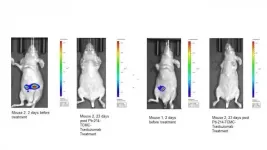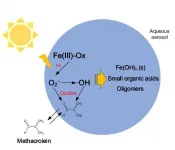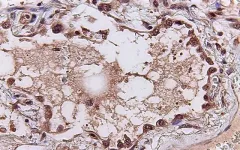An omega-3 that's poison for tumors
2021-06-11
(Press-News.org) So-called "good fatty acids" are essential for human health and much sought after by those who try to eat healthily. Among the Omega-3 fatty acids, DHA or docosahexaenoic acid is crucial to brain function, vision and the regulation of inflammatory phenomena.
In addition to these virtues, DHA is also associated with a reduction in the incidence of cancer. How it works is the subject of a major discovery by a multidisciplinary team of University of Louvain (UCLouvain) researchers, who have just elucidated the biochemical mechanism that allows DHA and other related fatty acids to slow the development of tumours. This is a major advance that has recently been published in the prestigious journal Cell Metabolism.
Key to the discovery: interdisciplinarity
In 2016, Olivier Feron's UCLouvain team, which specialises in oncology, discovered that cells in an acidic microenvironment (acidosis) within tumours replace glucose with lipids as an energy source in order to multiply. In collaboration with UCLouvain's Cyril Corbet, Prof. Feron demonstrated in 2020 that these same cells are the most aggressive and acquire the ability to leave the original tumour to generate metastases. Meanwhile, Yvan Larondelle, a professor in the UCLouvain Faculty of Bioengineering, whose team is developing improved dietary lipid sources, proposed to Prof. Feron that they combine their skills in a research project, led by PhD candidate Emeline Dierge, to evaluate the behaviour of tumour cells in the presence of different fatty acids.
Thanks to the support of the Fondation Louvain, the Belgian Cancer Foundation and the Télévie telethon, the team quickly identified that these acidotic tumour cells responded in diametrically opposite ways depending on the fatty acid they were absorbing. Within a few weeks, the results were both impressive and surprising. "We soon found that certain fatty acids stimulated the tumour cells while others killed them," the researchers explained. DHA literally poisons them.
A fatal overload
The poison acts on tumour cells via a phenomenon called ferroptosis, a type of cell death linked to the peroxidation of certain fatty acids. The greater the amount of unsaturated fatty acids in the cell, the greater the risk of their oxidation. Normally, in the acidic compartment within tumours, cells store these fatty acids in lipid droplets, a kind of bundle in which fatty acids are protected from oxidation. But in the presence of a large amount of DHA, the tumour cell is overwhelmed and cannot store the DHA, which oxidises and leads to cell death. By using a lipid metabolism inhibitor that prevents the formation of lipid droplets, researchers were able to observe that this phenomenon is further amplified, which confirms the identified mechanism and opens the door to combined treatment possibilities.
For their study, UCLouvain researchers used a 3D tumour cell culture system, called spheroids. In the presence of DHA, spheroids first grow and then implode. The team also administered a DHA-enriched diet to mice with tumours. The result: tumour development was significantly slowed compared to that in mice on a conventional diet.
This UCLouvain study shows the value of DHA in fighting cancer. "For an adult," the UCLouvain researchers stated, "it's recommended to consume at least 250 mg of DHA per day. But studies show that our diet provides on average only 50 to 100 mg per day. This is well below the minimum recommended intake."
INFORMATION:
ELSE PRESS RELEASES FROM THIS DATE:
2021-06-11
What The Study Did: Researchers examined the associations between Medicare Advantage star ratings, which are created using data from all enrollees in a plan, and disparities in care for racial/ethnic minorities and enrollees with lower income and less education.
Authors: David J. Meyers, Ph.D., M.P.H., of the Brown University School of Public Health in Providence, Rhode Island, is the corresponding author.
To access the embargoed study: Visit our For The Media website at this link https://media.jamanetwork.com/
(doi:10.1001/jamahealthforum.2021.0793)
Editor's Note: The article includes conflict of interest ...
2021-06-11
What The Study Did: This survey study compared features of major depression in people with or without prior COVID-19 illness.
Authors: Roy H. Perlis, M.D., M.Sc., of Massachusetts General Hospital in Boston, is the corresponding author.
To access the embargoed study: Visit our For The Media website at this link https://media.jamanetwork.com/
(doi:10.1001/jamanetworkopen.2021.16612)
Editor's Note: The article includes conflict of interest and funding/support disclosures. Please see the article for additional information, including other authors, author contributions and affiliations, conflict of interest and financial disclosures, and funding and support.
INFORMATION:
Media advisory: The full study is linked to this news release.
Embed this link to provide ...
2021-06-11
Reston, VA (Embargoed until 11:00 a.m. EDT, Friday, June 11, 2021)--Preclinical trials of a new radiopharmaceutical to treat ovarian cancer have produced successful results, dramatically limiting tumor growth and decreasing tumor mass. Designed specifically for ovarian cancers that are resistant to traditional therapies, the new radiopharmaceutical can be produced in 25 minutes at low cost, which leads to better efficiency compared with alternative methods. This research was presented at the Society of Nuclear Medicine and Molecular Imaging 2021 Annual Meeting.
According to the American Cancer Society, more than 20,000 women are diagnosed with ovarian cancer each year and nearly 14,000 ...
2021-06-11
What The Study Did: This autopsy study examines differences in skeletal muscle and myocardial inflammation in patients who died with COVID-19 versus other diseases.
Authors: Tom Aschman, M.D., and Werner Stenzel, M.D., of the Charite-Universitatsmedizin Berlin, are the corresponding authors.
To access the embargoed study: Visit our For The Media website at this link https://media.jamanetwork.com/
(doi:10.1001/jamaneurol.2021.2004)
Editor's Note: The article includes conflicts of interest and funding/support disclosures. Please see the article for additional information, including ...
2021-06-11
The Fenton reaction is a chemical transition involving hydrogen peroxide (H2O2) and the ferrous (iron) ion, which acts as a catalyst. This process is used to destroy hazardous contaminants in wastewater through oxidation. In the atmosphere, a similar reaction, or "Fenton-like" reaction, occurs continuously with ferric oxalate([Fe(III)(C2O4)3]3-) and aerosols suspended in the air. This is the most frequent chemical reaction that occurs in the atmosphere. A particle's ability to oxidize is directly related to its phase, either gaseous or aqueous, which has an important impact on secondary organic aerosol (SOA) formation. Therefore, research is necessary not only to evaluate the contribution of this ...
2021-06-11
Researchers at University of California San Diego School of Medicine used an artificial intelligence (AI) algorithm to sift through terabytes of gene expression data -- which genes are "on" or "off" during infection -- to look for shared patterns in patients with past pandemic viral infections, including SARS, MERS and swine flu.
Two telltale signatures emerged from the study, published June 11, 2021 in eBiomedicine. One, a set of 166 genes, reveals how the human immune system responds to viral infections. A second set of 20 signature genes predicts the severity of a patient's disease. For example, the need to hospitalize or use ...
2021-06-11
Astronomers from University of Warwick and University of Exeter modelling the future of unusual planetary system found a solar system of planets that will 'pinball' off one another
Today, the system consists of four massive planets locked in a perfect rhythm
Study shows that this perfect rhythm is likely to hold for 3 billion years - but the death of its sun will cause a chain reaction and set the interplanetary pinball game in motion
Four planets locked in a perfect rhythm around a nearby star are destined to be pinballed around their solar system when their sun eventually dies, according to a study led by the University of Warwick that peers into its future.
Astronomers have modelled how the change in gravitational forces in the system as a result ...
2021-06-11
When is a weed not a weed?
Can native plants be weeds?
Sweet pittosporum (Pittosporum undulatum) was once a well-behaved tree growing in gullies from Gippsland in Victoria up to Brisbane in Queensland.
But it is now a major problem, leading to an almost complete suppression of native vegetation where it has invaded. Programs to clear it have successfully allowed indigenous plants to return, and within 15 years, with moderate follow up, treated sites are well on the way to successful restoration.
However, there has been some debate on whether this is good or bad for birds such as the threatened Powerful Owl.
New research by Monash University scientists from the School of Biological Sciences published today in Ecological Solutions and ...
2021-06-11
Astronomers have spotted a giant 'blinking' star towards the centre of the Milky Way, more than 25,000 light years away.
An international team of astronomers observed the star, VVV-WIT-08, decreasing in brightness by a factor of 30, so that it nearly disappeared from the sky. While many stars change in brightness because they pulsate or are eclipsed by another star in a binary system, it's exceptionally rare for a star to become fainter over a period of several months and then brighten again.
The researchers believe that VVV-WIT-08 may belong to a new class of 'blinking giant' binary star system, where a giant star ? 100 times larger ...
2021-06-11
Oncotarget published "The presence of polymorphisms in genes controlling neurotransmitter metabolism and disease prognosis in patients with prostate cancer: a possible link with schizophrenia" reported that polymorphisms of neurotransmitter metabolism genes were studied in patients with prostate cancer (PC) characterized by either reduced or extended serum prostate-specific antigen doubling time corresponding to unfavorable and favorable disease prognosis respectively.
The following gene polymorphisms known to be associated with neuropsychiatric disorders were investigated:
A. The STin2 VNTR in the serotonin transporter SLC6A4 gene;
B. The 30-bp VNTR in the monoamine oxidase A MAOA gene;
C. The Val158Met polymorphism in the catechol-ortho-methyltransferase ...
LAST 30 PRESS RELEASES:
[Press-News.org] An omega-3 that's poison for tumors




